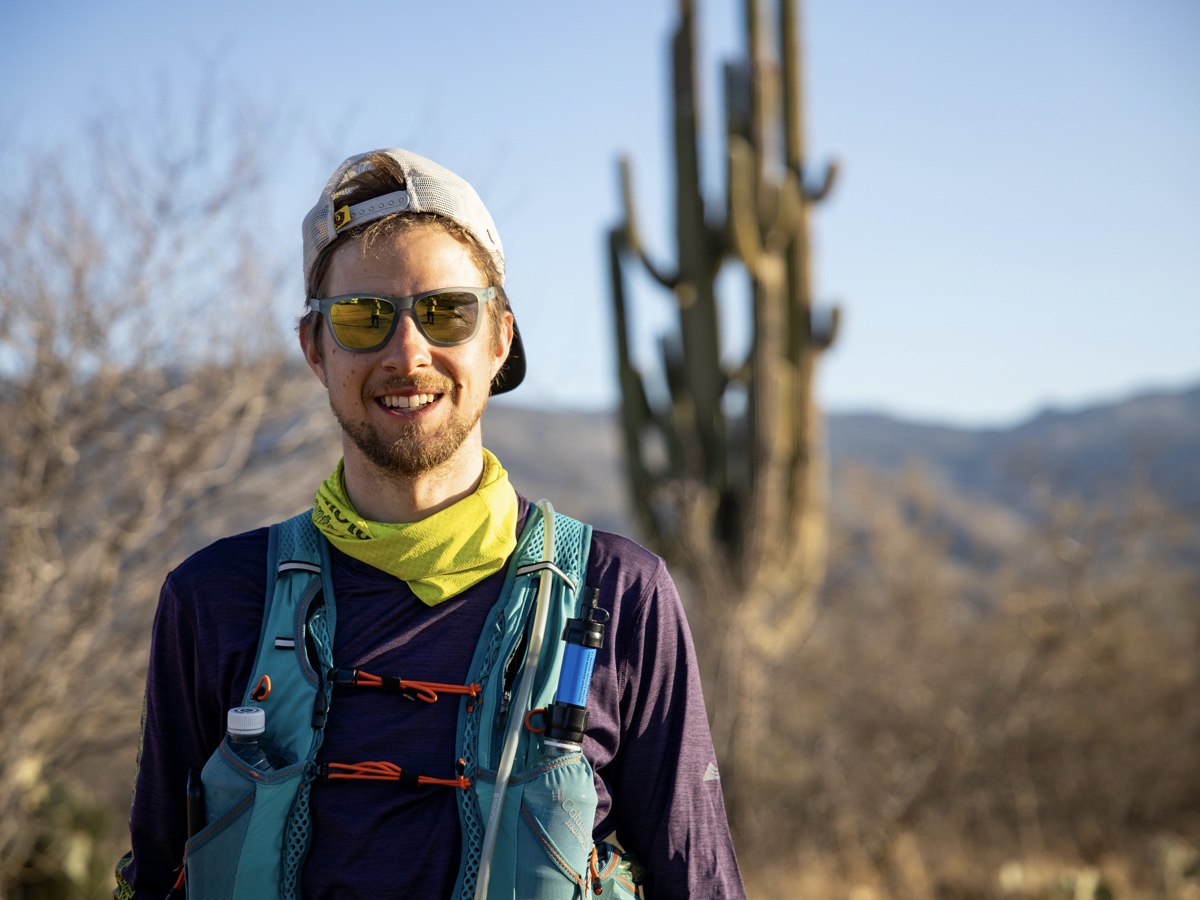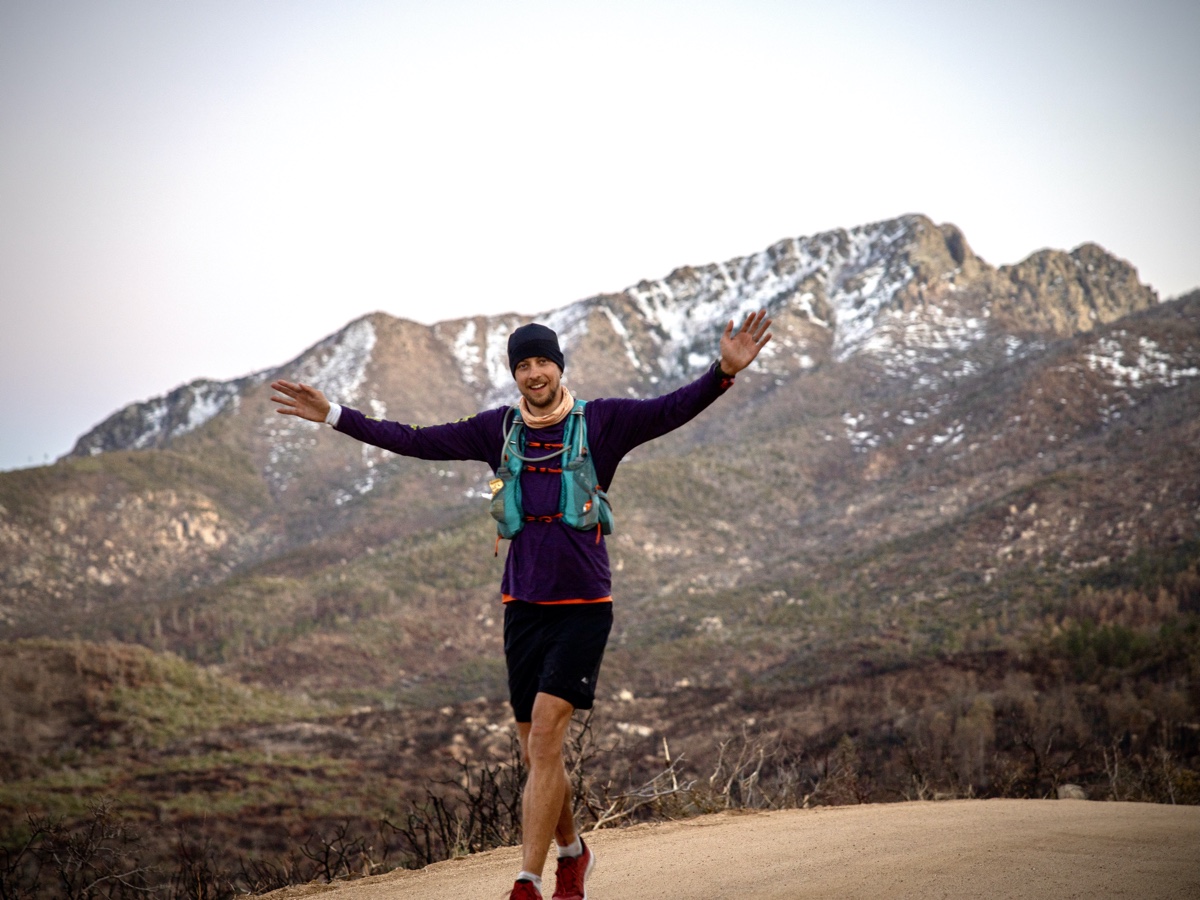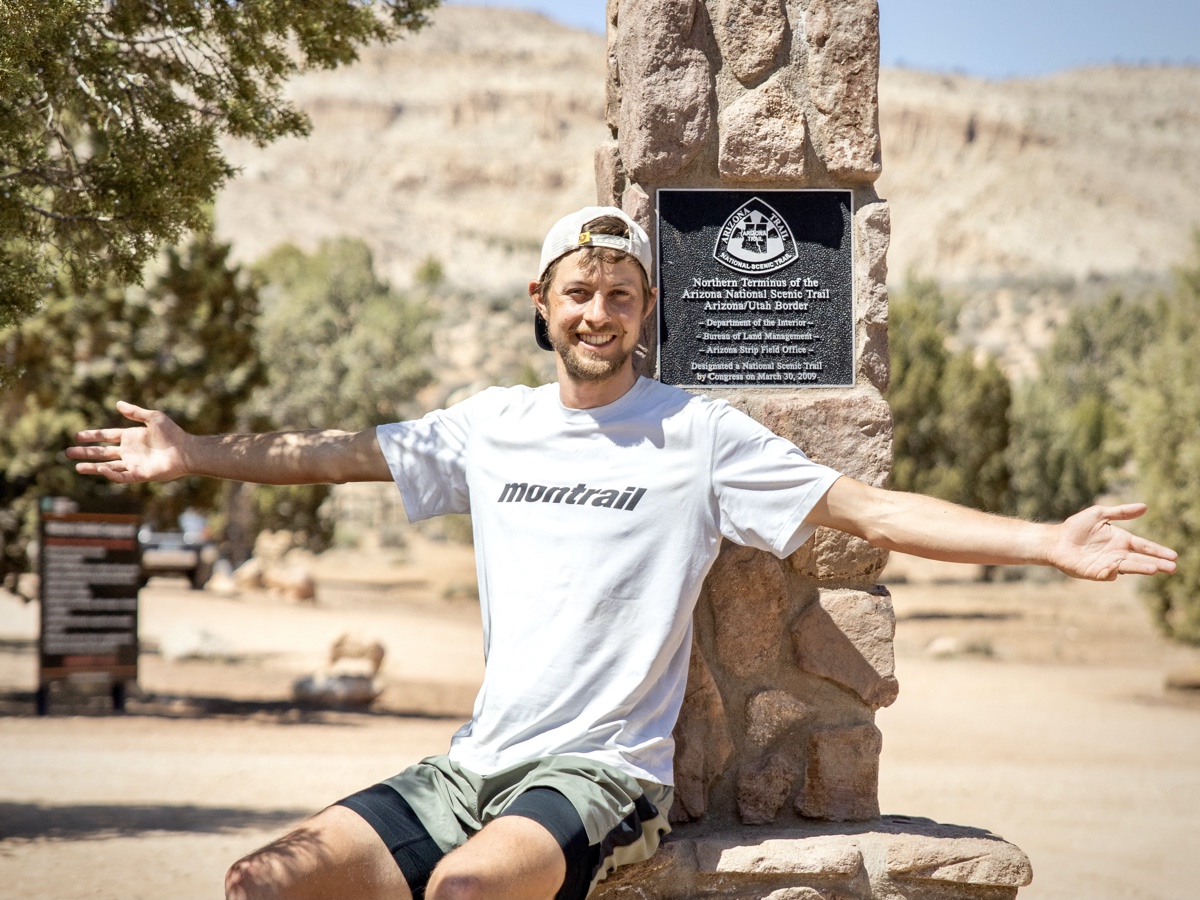In March and April of 2021, Joe McConaughy aka Stringbean set a new men’s supported fastest known time (FKT) of 13 days, 3 hours, and 21 minutes on the Arizona Trail, which spans the state of Arizona north-to-south over the course of 800-ish miles of desert and mountains. The previous record of 15 days, 22 hours, and 39 minutes was set by Michael Versteeg in 2016. In this phone interview a few days after his finish, Stringbean walks us through his logistical planning and training, some of the highs and lows of his almost two weeks on trail, his run-in with nearly show-stopping snow near the end of his attempt, and more.
iRunFar: Congratulations, Joe! How are you?
Joe “Stringbean” McConaughy: I am chilling.
iRunFar: What does that mean for you exactly?
McConaughy: I am on the couch with my legs up and ice on my ankles.
iRunFar: How is your recovery going?
McConaughy: I’m recovering pretty well. It’s Achilles stuff, and weirdly blisters. Blisters came at the end. My ankle joint and blisters are making life not that fun right now.
iRunFar: When I look at the different trails you’ve done, it’s a huge mix. You do long things, short things, high altitude things, now this desert thing. Big picture, why did you choose the Arizona Trail?
McConaughy: I’ve eyed the Arizona Trail for a while. You pick the trail for the trail, but there are also other things in life. My wife and I were thinking we might move to Arizona because she’s getting into a graduate program that would either be in Flagstaff or Seattle, Washington. If we ended up moving to Arizona, this would be the coolest way to see the state.
iRunFar: The whole state. [laughs]
McConaughy: Yeah, literally the whole state. From a trail perspective, the Arizona Trail is that sweet middle ground where it’s not as long as the Appalachian Trail or Pacific Crest Trail, which is a year-long project to plan and do. It’s long enough that it has a lot of logistical challenges and it’s that medium length where you need the physical strength to make it through. It’s also such an amazingly beautiful and runnable trail—the elevation change per mile isn’t crazy. But you’re so long over sky-island desert and some technical trails. The Arizona Trail is an amazing FKT trail because it has a variety of challenges but also a lot of opportunity for strong running. It doesn’t have that same kind of punch in the mouth of an East Coast trail.
iRunFar: The Arizona Trail is remote in some places and close to towns and highways in others. Did you and your crew recce the trail and the logistics ahead of time?
McConaughy: I have a cheat code in El Matador, Witt Wisebram. He’s a previous self-supported FKT holder on the Arizona Trail and he was in my crew. He’s one of the guys I coach. He’s done the trail three times, so he’s a wealth of knowledge. My brother lives in Tucson. I hadn’t done a lot of on-the-ground running on the trail other than a few trips out to Flagstaff and Tucson.
But I can’t tell you how many hours my wife Katie McConaughy and I spent putting in GPS waypoints on maps. We mapped out every road crossing beforehand, vetted how accessible we thought the more rugged ones were. And with Witt, we figured out some local options. For example, the Gila River section is a hard place for a resupply. You basically have 16 miles on the river and another 20 miles up and over canyons and mountains. It could be a 30-plus-mile non-resupply section. There are some jeep roads that you’d need a hardcore 4×4 vehicle for, but Witt’s friend tipped him off to this road on the south side of the Gila River so they were able to drive in. Witt forded the Gila River with a resupply bag of food and water and hooked me up. I can’t underscore how well the crew did.
iRunFar: One question I hear ultrarunners ask about thru-hiker/ultrarunning combination efforts like this is how one physically trains for it. How do you prepare for running and hiking 50 to 70 miles a day for two weeks? [laughs]
McConaughy: You’re trying to have similar physiological adaptations as you get for ultrarunning. I train like a runner. Hiking doesn’t get you in suddenly fast or long shape. It does get you in solid shape, but I’d rather be taking the benefits you can get from running.
The biggest weakness is the joints and tendons. That’s what the whole effort comes down to. People worry about fitness and fatigue, but what inevitably breaks down is some joint or system. Once I have that strong aerobic engine that you’d see in an ultrarunner, I work to simulate the extreme ups and downs that I’ll experience. Because that’s a big part of where your tendons will break down. It’s super common to see Achilles and ankle injuries, those lower joints that are handling a lot of stress on those ups and downs. And that can of course be affected by the actual muscles themselves, but things like blisters or snow will cause them, too.
iRunFar: On social media, you said you wanted to run the trail in 12 days, which is a lot faster than the previous FKT. Did you go into it with that plan?
McConaughy: For sure. I went out averaging 65 to 70 miles per day. Through day 8, I was probably in the mid- to high 60s. Then I hit a few bumps with snow that caused some slow down. Particularly, you get up on the Mogollon Rim which is close to mile 450. Maybe 15 miles worth of snow there slowed me down enough to tamper my case a bit. Then we did another 10 or 15 miles of deeper snow around Mount Humphreys by Flagstaff. And then, I probably would have finished around 24 hours faster if I didn’t hit snow on the Kaibab Plateau north of the Grand Canyon.
iRunFar: I like it when people put their goal out there and say, “Yeah, I think it can be done in this amount of time.” Twelve days is quite a bit faster than what anyone had done before. I’m wondering the mental machinations behind that number?
McConaughy: The most fun part of this is having an ambitious goal and then going for it. I planned to start the attempt with around 16 hours per day on feet, cranking that up to 18 hours per day on feet, and then two days out just putting as much of a blitzkrieg as I could to finish. When I was doing that math, I thought that if things go right, 11.5 days was where I’d fall.
The crux of this A goal was the Mount Lemmon section, which was 66 miles with 17,000 feet of vertical, and then there were two mid-70-mile days with 10,000 feet of vert a few days later. I got through the Mount Lemmon section and then did a 75-mile day. That 75-mile day threw my sleep off. Though I was still on pace two days later, there was no way I was pulling off those back-to-back mid-70-mile days. So I started to falter a little bit from that A goal on day five and then when day seven came around, I hit a little snow and my body just wasn’t there. That’s when I went off that 11.5-day train.
iRunFar: The Arizona Trail is tricky. Depending on when you do it, you either have heat or snow that becomes your main impediment. I’m guessing you were trying to dance in between those as best you could?
McConaughy: I definitely went a little too early. We even had somewhat favorable snow conditions for this time of year and it still caused me to get off trail.
The heat was pretty manageable. Now, a heat wave went through Tucson where it’s 100-plus degrees Fahrenheit. I probably was at mid-70s or low 80s when I went through there.
The snow was the big factor. The stupidest part about my planning was that we trusted a Snotel map overlay. They have almost zero Snotel monitors on the north Kaibab Plateau, so the overlay uses pretty much all calculations to figure out snow levels. About 12 hours before we were on the Kaibab Plateau, the Snotel map said that there was no snow on trail which was the farthest thing from the truth.
iRunFar: I appreciated the photos and videos that your crew put out from that section. You guys were thigh deep.
McConaughy: It was so bad. We were all cut up from it.
iRunFar: You can laugh about it now, but you said on social media that you actually quit and then unquit and got through it. Walk us through that.
McConaughy: Yeah, so we hit the North Rim of the Grand Canyon. The highway north of the Grand Canyon is closed for the winter until May 15, so we weren’t going to have any support from the South Rim of the Grand Canyon until approximately 70 miles later [when we got past the closed road]. A friend of ours, Mikaela Osler who has the women’s self-supported Colorado Trail [Collegiate West version] FKT, was going to stash water.
Witt was running with me, and he and I arrived and met her with maybe 25 or 30 miles to go in that 70-mile section. At that point we were thinking clean, clear sailing until end of the trail. We probably hit a little bit of snow because the Gaia [Snotel map overlay] showed some snow on it, but we thought we’d be able to push through like we had with other bits of snow. Witt and I did a huge celebration at the North Rim.
I think we did seven miles after the North Rim and we postholed the whole way, up to our hips in points. You’d have a section of 30 steps that were shin deep and then the next 30 steps were thigh deep. The funniest part is, in this area, the Arizona Trail is right next to that closed highway, which was paved, unused, and snow-free. [laughs]
iRunFar: And you had to be on the trail exactly.
McConaughy: Yeah. We only had two space blankets, a bivvy, and a windbreaker. We didn’t have any winter clothes as we didn’t imagine we’d get stuck in snow. After about seven miles, it was 5:00 or 5:30 p.m. and we thought it would be dangerous to continue. We’d heard rumors there was some forest-road access to the Grand Canyon North Entrance. We ended up getting off trail, hiked four miles to that entrance, set up in space blankets, and went to sleep. We had gotten a text from the crew that they had been able to access the forest roads, so about an hour later they drove in.
It was this crazy intervening. They brought food and water. The crew had snowshoes, so I decided to use them. I went about a mile and a half at 45-minute-mile pace, still postholing up to my shins. Also my ankle had given me a lot of issues and the snowshoes were aggravating my ankle. I couldn’t imagine putting it through 20 hours of this kind of work, what it could take to get through the snow section. I told my crew, “I think we have to call it. I can’t can’t push through this.” We went to a motel to sleep.
iRunFar: Wow.
McConaughy: I woke up the next day and pretty much everybody on my crew came to me at a different point saying, “Hey man, really sorry. Are you sure you’re out?” Four conversations with four different people, and I was like, “If they think I can push through it, then we can’t give up now.” They really helped me come back and give it a second chance.
iRunFar: You painted that picture really well.
McConaughy: I experienced it for a very long time. [laughs]
iRunFar: Could you shoutout your crew? They were so integral to the experience.
McConaughy: Yeah, totally. Katie McConaughy, she’s my wife. She is the Chief of Operations. She’s super detail oriented and very empathetic and has seen me do a lot of dumb stuff. She knows where to push me and not to push me. She went above and beyond with the details.
Witt Wisebram, El Matador, he hiked the trail twice and then he decided to an FKT in 2017. He also brought a campervan, which was an amazing addition. We call him Chief Mileage Officer. He put in big miles. And I got to this point where I needed to wash my feet at every resupply spot to keep them healthy, and he washed my feet every single time. Popped blisters twice a day. Put in a ton of miles. It was big.
We also had Jack Murphy and Michael Dillon. They were both with me on the Pacific Crest Trail in 2014. Dills, or Michael Dillon, is a good friend from college. He has his own film company, and he filmed the entire thing. They had a funny role because they were part support crew, part film team. They always had a camera in their hands and they were also doing smaller tasks.
I also had my brother, Will McConaughy. He’s an avid rock climber but not much of a runner, and he was amazed by all the details that went into this. He was the perfect plug-and-play guy who was willing to do anything and everything.
We also had my mom, Mary Ann, and Crash Bandipooch, my dog.
iRunFar: The dog’s name is amazing. [laughs]
McConaughy: Do you know the game Crash Bandicoot? It’s a video game from the 1990s. We got him in November, so he’s a little bit new, so my mom was the dog handler. But also she had the third support vehicle, so anytime we needed extra errands, she was super useful.
iRunFar: Last question, what was the craziest moment or thing you saw? Wildlife, snakes, ghosts, hallucinations?
McConaughy: The weirdest one was going up Reavis Canyon, a 2,500-foot climb. It was a full moon, and everything was lit up and beautiful. I was going up this climb and I look to the side maybe 100 feet away, and I see two eyes staring back. I was like, “That looks awfully like a mountain lion.” So I keep walking and of course the trail takes a corner and there’s a 10-foot embankment that I can’t see over. I’m imagining that just over it is a mountain lion waiting to pounce. Then I heard a noise and I yanked my headlamp up to the right.
iRunFar: But nothing happened? Just a big pair of big eyes in the night?
McConaughy: Yep, exactly.
iRunFar: Phew! This was a great interview, thank you so much. Congratulations!





